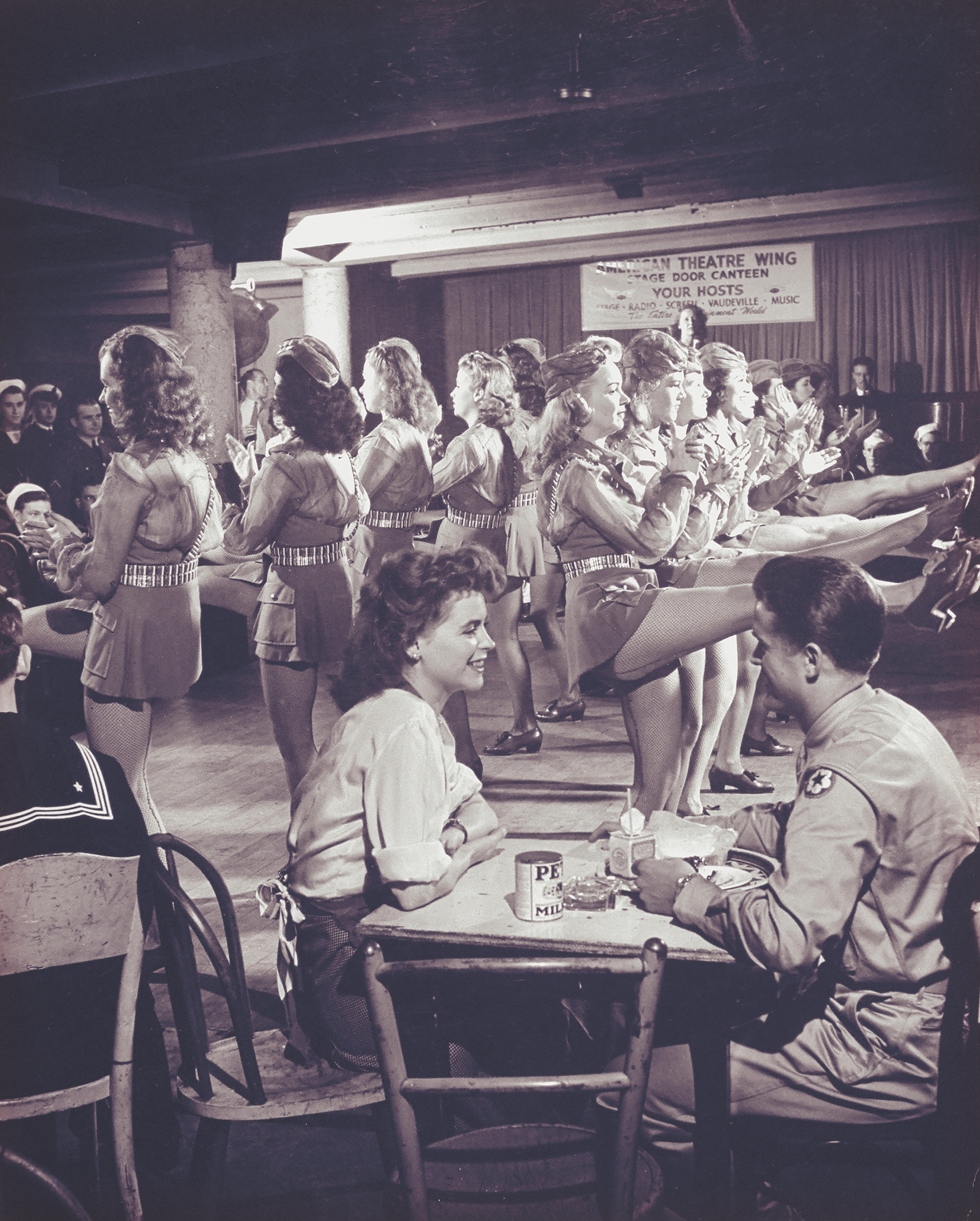During World War II American servicemen could take a break at a Stage Door Canteen.
Picture a GI from the heartland, on leave with a day or two in New York City in the summer of 1942. Lonely, he wanders into Times Square and is overwhelmed by the lights, the traffic, the people with someplace to go. Glancing down a side street, though, he spots a line of khaki-clad soldiers just like him. He walks up to them and asks what’s going on. It’s the Stage Door Canteen, he’s told—free food, entertainment, and girls to dance with! He falls in at the end of the line, now with someplace to go.
More than 350,000 servicemen like him had tasted the hospitality of New York’s Stage Door Canteen by August 1942, consuming an average of 2,000 sandwiches, 3,000 cups of coffee, and 5,000 cigarettes every night. While they were eating, drinking, and smoking, they took in music and acts provided by Broadway talent. Probably most important to the servicemen were the junior hostesses—to dance with, to talk to, or just to remember on their next posting. Word of the new entertainment venue even spread to the men on U.S. ships in the Atlantic as signalmen transmitted messages like “Don’t miss the Stage Door Canteen!” and “No liquor, but damned good anyway.”
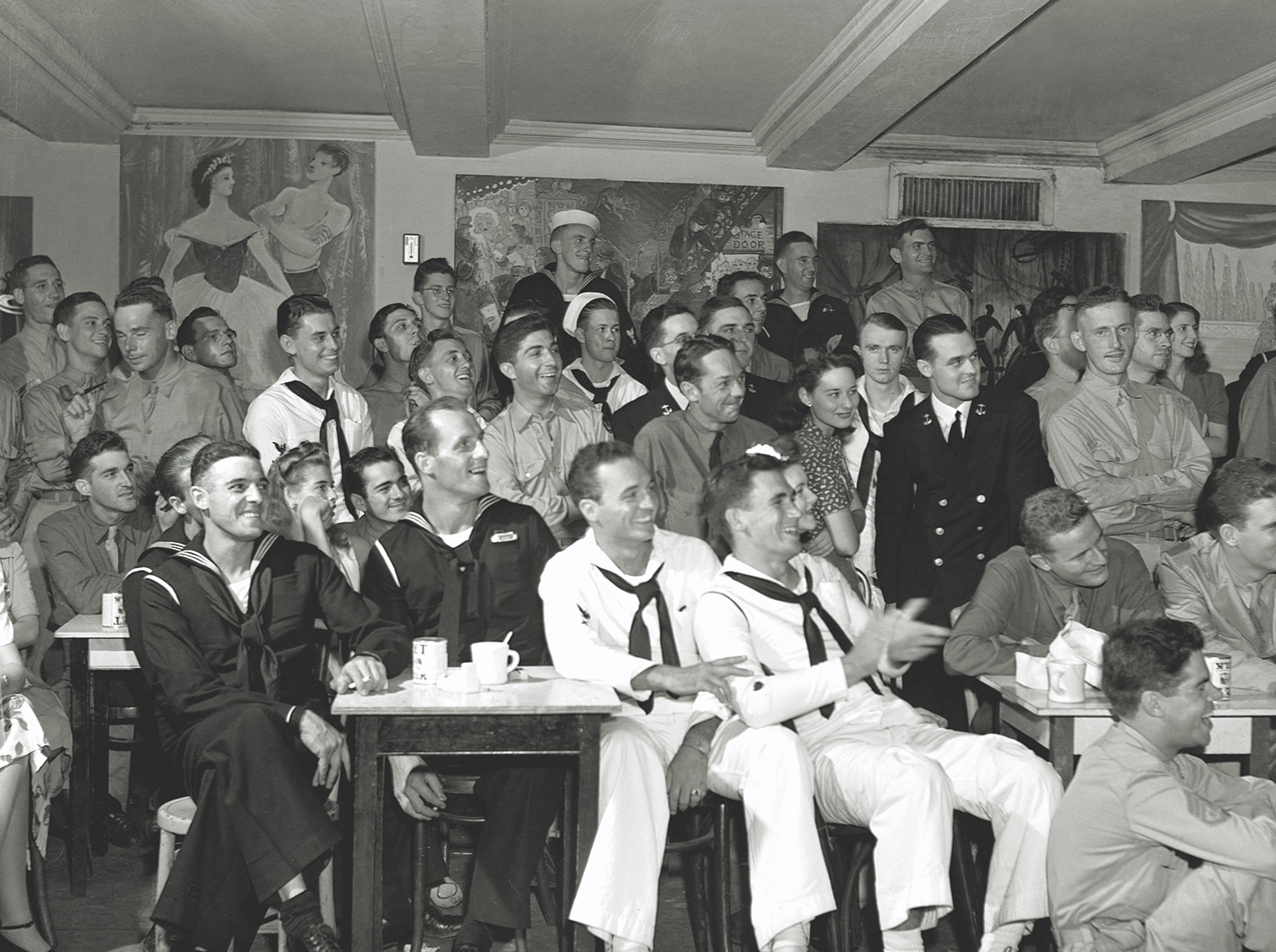
The Stage Door Canteen was organized and run under the auspices of the USO’s American Theatre Wing. Playwright Rachel Crothers had laid some groundwork for the operation with the formation of an Allied Relief Fund after the outbreak of World War II in Europe. Following America’s entry into the war, it morphed into the American Theatre Wing War Service, with Crothers serving as its president and stage director Antoinette Perry (for whom the Tony Awards were named) as its chairman and secretary. Actresses Gertrude Lawrence and Helen Hayes, a Brit and an American, respectively, were vice presidents. Producer Brock Pemberton, who had often worked with Perry, was on its men’s committee.
Crothers and her colleagues moved fast. Within three months of Pearl Harbor they had opened the flagship Stage Door Canteen in the basement of the 44th Street Theater, half a block from Times Square. There were half a dozen other Broadway houses on the block, including the Shubert, the Majestic, and the St. James. The New York Times, on West 43rd, had purchased the 44th Street Theater as the possible site for a future printing plant. In the meantime, though, the Times had leased the theater to producer Lee Shubert, who offered its lower level rent free to the Stage Door Canteen. Until 1940 this had been the home of the Little Club, a swank after-theater hangout and nightclub that had made a big name for itself in the days of Prohibition. The space measured about 40 by 80 feet, with a capacity of 500 patrons. Jo Mielziner and other Broadway designers livened up the walls with murals; composer Irving Berlin donated a piano.
The Stage Door Canteen opened on March 2, 1942, and became an instant success. Gertrude Lawrence brought some of her costars from their hit musical Lady in the Dark. Other actresses served as hostesses, and actors worked as busboys. From 5 p.m. to midnight, some 1,250 servicemen had sampled the congeniality at the former rathskeller.
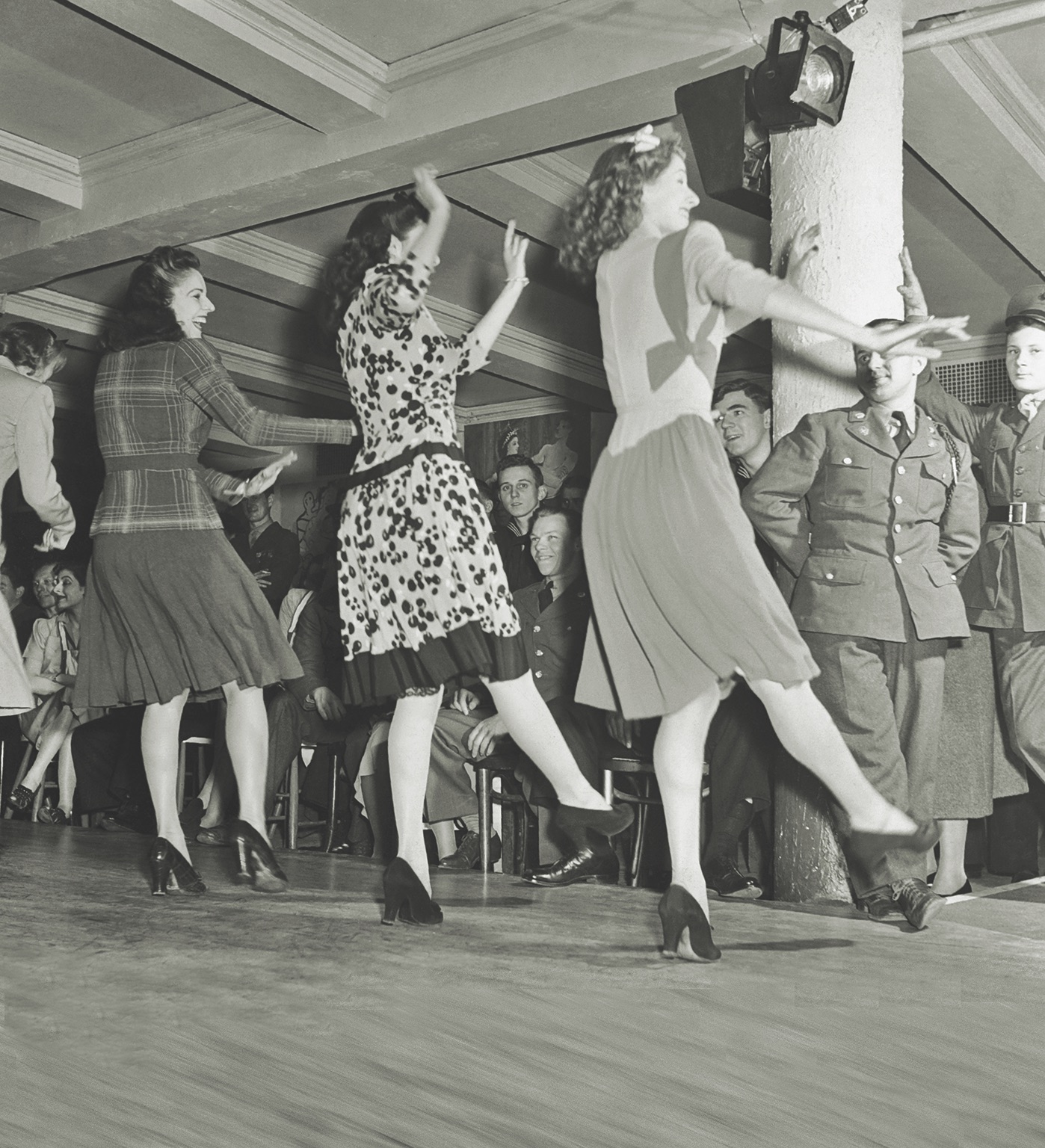
Given New York City’s big stamp of approval, Stage Door Canteens soon opened in Washington, D.C., and other major American cities, including Boston, Cleveland, New Orleans, Philadelphia, and San Francisco, and in Hollywood, the last being spearheaded by actress Bette Davis. Most were located in or near their cities’ live entertainment centers. Washington’s, however, was across Pennsylvania Avenue from the White House, in Lafayette Square.
These canteens were generally organized like New York’s. After a suitable location was secured, the call went out for furnishings and equipment: pianos, kitchen appliances, tables and chairs, books and games, and phonographs or jukeboxes for when live music was unavailable. Some canteens sponsored “package parties,” for which admission was a donation of canned goods, condiments, or cooking staples such as flour and sugar. Soft-drink suppliers were solicited, but alcoholic beverages were absolutely off limits on all USO premises.
Just as vital was the need for hundreds of volunteers, all to serve without compensation. Women were needed to staff the kitchens and act as older hostesses—substitute mothers for homesick soldiers and sailors. Men bused tables and did the heavy lifting. Alfred Lunt, arguably Broadway’s greatest actor but a recognized amateur chef as well, worked both in and out of the kitchen.
As for the canteens’ clients, one necessity stood above all. Asked by a senior hostess what he would like, a sailor in the Washington, D.C., canteen didn’t mince words. “Women!” he said. “Bring on the women!” These were the young and mostly unmarried junior hostesses who served as ice breakers, dancing partners, and companions. In New York many were aspiring actresses or chorines between shows, and many a callow sailor or soldier got to talk or dance with a 19-year-old named Lauren Bacall before Hollywood teamed her up with Humphrey Bogart.
Community theater groups and high school or college drama classes outside New York were prime recruiting grounds. Once accepted, junior hostesses were issued red-white-and-blue-striped aprons for canteen duty and given a pocket-size booklet of tips in the form of doggerel:
So, now you are a hostess in the famous
Stage Door Canteen!
And you’re more frightened than in all
your life you’ve ever been.
Well, pull yourself together and learn
this from all the rest
That once you get the hang of it,
you’ll work with fun and zest.
The thing you must remember is to be a happy gal—
An able conversationalist, a dancer and a pal.
Also keep it in your mind your petticoat to hide,
For skirts these days are very short and
when you dance they ride.
And so on through five more stanzas, including the following stricture:
You know the rule on dating every
night you here appear.
Don’t blame the rules too harshly;
It’s for your protection, dear.
The rule on dating was strictly prohibitive: Junior hostesses were forbidden to give servicemen their phone numbers, addresses, or even their last names, nor were they to be seen leaving the canteen with one. Senior hostesses were to act as chaperones, without being too obvious about it. Junior hostesses were also warned that “talk of war must be taboo,” lest useful information such as ship assignments reach Axis ears. The FBI even ran background checks on prospective hostesses.
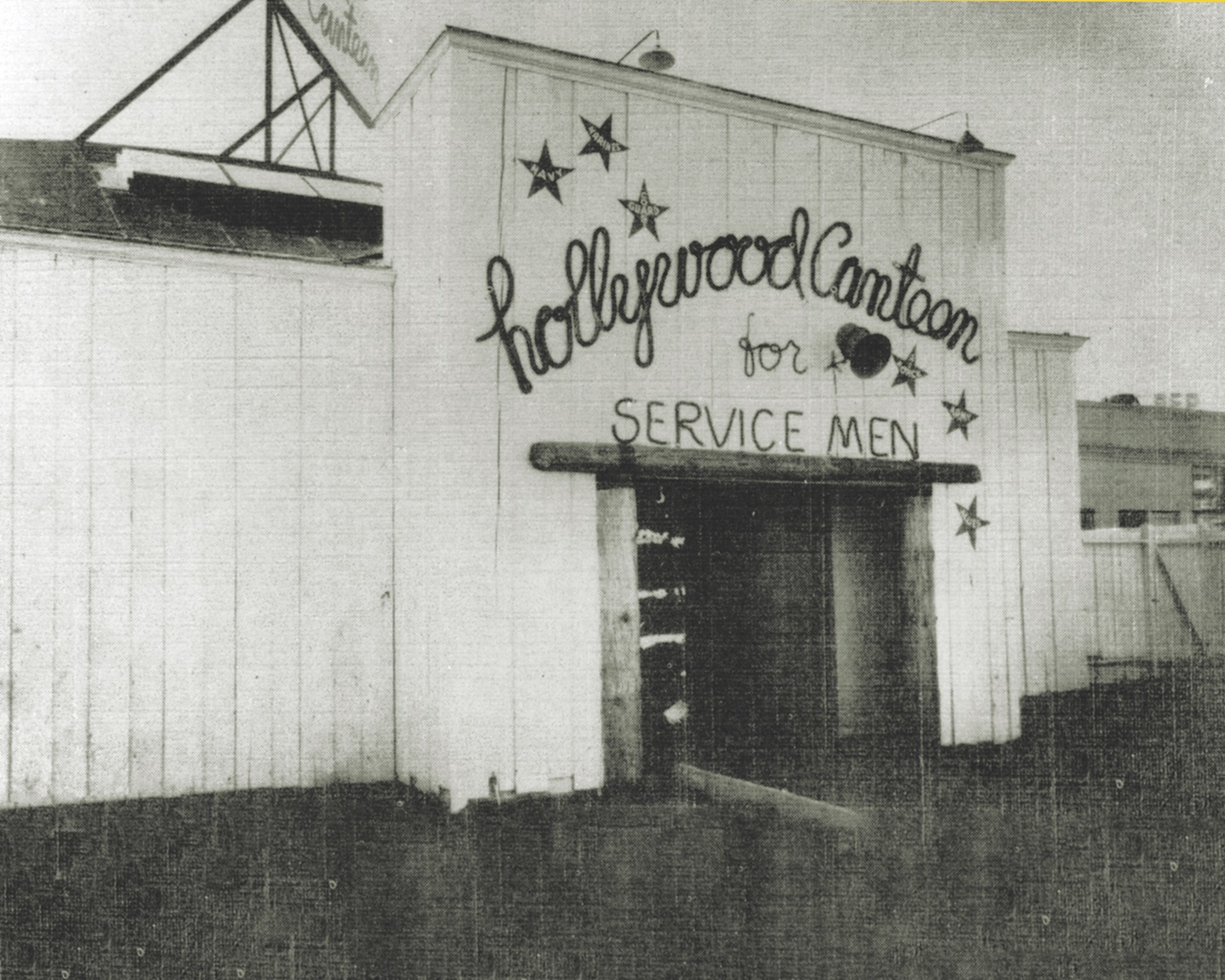
Maintaining order was among the duties of the male volunteers. Merchant seamen were a problem in the early days of the New York canteen, largely because of their rough language and manners. The solution: providing them with their own canteen and barring them from the Stage Door. If any trouble threatened to break out among regular servicemen—escalating trash talk between sailors and soldiers, for instance—canteens were advised to play “The Star-Spangled Banner.” Anyone in uniform who didn’t snap to attention was subject to military arrest, though who would do the arresting was left unstated.
In general, the national anthem wasn’t needed to maintain order. Big-name entertainment usually took place early in the evening, before the headliners had to leave for their regular gigs. Life magazine visited the New York canteen when actress Dorothy McGuire took a break from her Broadway hit Claudia to don a hostess apron and dance, mingle, and play parlor games with the GIs. Taking the show on tour, McGuire paid similar calls when she played cities with their own canteens.
One night Vice President Henry A. Wallace dropped in the canteen in Washington, D.C., and announced, “I’ll Indian rassle any man in the house and beat him.” A husky soldier took him up on it and quickly found his knuckles hitting the floor. (Wallace had toughened his wrists by shucking corn as a farm boy in Iowa.) A VIP volunteer was Donald Nelson, head of the War Production Board, who might be seen clearing tables. “Are you really Donald Nelson?” a dubious sailor asked. “Sorry, buddy,” Nelson replied. “We busboys aren’t allowed to give out our names or telephone numbers.”
Screen star Rita Hayworth, perhaps the servicemen’s most popular pinup, dropped in the Hollywood Canteen with an offer to kiss any serviceman celebrating his birthday. The number of claimants shattered all the laws of probability. Then there was Bob Hope. When the comedian showed up with his radio troupe at the canteen in his hometown of Cleveland—he was the canteen’s honorary chairman—2,000 servicemen jammed into a space with 500 seats, many standing on the tables for a better view. They stamped their feet so lustily in response to the jokes Hope delivered with his sidekick, Jerry Colonna, that one table gave way and hit the floor.
Servicemen at the Philadelphia canteen could draw lots each weekend for free long-distance telephone calls. One winner placed a call to his mother in Colorado but didn’t get to say much because she fainted away at the unexpected sound of his voice. (Long-distance calls were expensive and rare in those days.) Another soldier in the same canteen left an unfinished draft of a letter home behind: “Dear Mom, Guess what? Hedy Lamarr just walked by….”
Back on Broadway, a young actress came into the West 44th Street canteen with tickets for a musical opening that night just up the street in the St. James Theater. She was playing the ingenue role, and there were still seats to fill for the premiere. So the actress, who had been a canteen hostess before winning her role, had come back to paper the house with free tickets for servicemen.
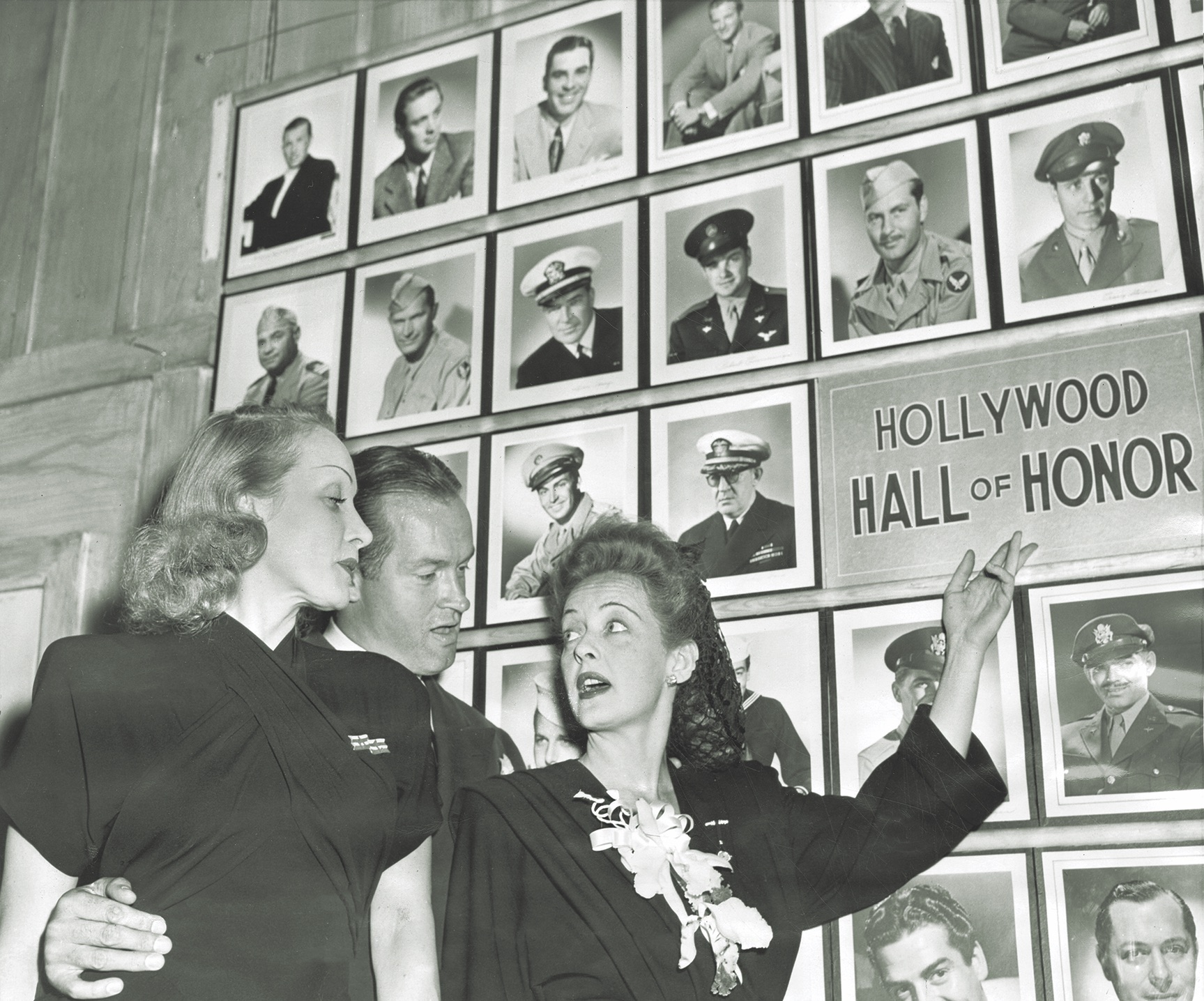
Those who took advantage of her offer witnessed a landmark theatrical first night. The actress’s name was Celeste Holm, and the show was Oklahoma! From the following day on, for years to come, the lines in the morning to buy tickets for Oklahoma! would be longer than the lines in the evening to get into the Stage Door Canteen.
Months later another hit show opened just above the canteen in the 44th Street Theater. Produced by the U.S. Army Air Forces for the benefit of the Army Emergency Relief Fund, Winged Victory was performed by a huge cast of Air Force personnel who would have been just as welcome at the Stage Door Canteen as they were onstage upstairs. Among them were Private Red Buttons, Private Lee J. Cobb, Staff Sergeant Peter Lind Hayes, Private Karl Malden, Sergeant Kevin McCarthy, Private First Class Edward McMahon, Corporal Gary Merrill, and Private First Class Edmund O’Brien.
Winged Victory was the Air Force’s answer to Irving Berlin’s all-soldier revue This Is the Army, which had opened at the Broadway Theater on July 4, 1942. One of its scenes took place at the Stage Door Canteen, and GIs in uniform and drag played the canteen’s guests as well as hostesses. Out of it came the biggest song hit of the show, “I Left My Heart at the Stage Door Canteen,” introduced by Corporal Earl Oxford.
Radio and movies did their part in publicizing the contribution of the Stage Door Canteen to the war effort. On July 30, 1942, CBS launched a weekly radio show, “Stage Door Canteen,” which ran for the duration of the war, and the big motion picture studios chipped in with feature films—RKO with Stage Door Canteen and Warner Brothers with Hollywood Canteen. The former was described by a reviewer as “a simple little tale about three average American soldiers who are about to embark for active duty overseas and spend their last nights at New York’s Stage Door Canteen.” Each one has a necessarily curtailed romance with one of the canteen’s hostesses before duty calls him away.
While the three soldiers and their sweethearts were played by relative unknowns, the real stars were the stage celebrities who happened to drop in and do their “bits”: Ethel Waters sang “Quicksand”; Edgar Bergen did a comic dialogue with Charlie McCarthy, his diminutive alter ego; Gracie Fields performed an odd coupling of “The Lord’s Prayer” and “The Machine Gun Song”; Katharine Cornell recited Juliet’s balcony scene to a GI Romeo; and Gypsy Rose Lee did a modified strip-tease number. Six bands, including those of Guy Lombardo and Count Basie, took turns providing the dance numbers. Like canteen personnel, all acts contributed their services, and a portion of the box office take was earmarked for the Stage Door Canteens.
A year later Hollywood Canteen followed roughly the same formula, only focusing on a single soldier and his crush on actress Joan Leslie (played by herself). Jack Benny, Joan Crawford, Bette Davis, Sydney Greenstreet, Peter Lorre, Barbara Stanwyck, and other stars had cameos. Roy Rogers even came by with Trigger and happened to run into the Sons of the Pioneers, who backed him in singing Cole Porter’s “Don’t Fence Me In.”
Such concentrations of talent were far from typical in even the New York and Hollywood canteens. When they were on tour, the big names still made their rounds of the more provincial canteens—Lena Horne, Martha Raye, Tommy Dorsey, Stan Kenton, Perry Como, and Woody Herman, to name a few. But the real draw for soldiers, as a biographer of Helen Hayes pointed out, was to dance with the comely young hostesses.
Most hostesses saw their service as a positive experience, both for its close look at show business and for the feeling of having done their bit in the war effort. Among the few exceptions, however, was a recent high school graduate who commuted from Westchester to the New York canteen for one or two evenings a week. “They wanted someone to talk to,” she remembered about the servicemen who came to the canteen, “and there was a desperate quality about the thing—like here you are, now sit down and be charming, sparkle—a very unnatural situation. I didn’t like it at all; I wasn’t good at it.”
Most did become good at it, to the point where junior hostesses in some canteens resented the presence of servicewomen as unwelcome competition for dance partners. WACS, WAVES, and other servicewomen were actually declared persona non grata at the Washington, D.C., canteen. Other canteens, after some initial awkwardness, perhaps, were more receptive.
There was little evidence of blatant racial discrimination in most canteens. The New York canteen was probably the most receptive to African American servicemen. On the other hand, black soldiers and sailors were rarely visible for whatever reasons in the Washington canteen, and Philadelphia didn’t provide African American dance partners until nearly the end of the war.
As the war entered its third and fourth years (for Americans, at least), the Stage Door Canteen had to cope with new exigencies. The movies and Berlin’s hit song had aroused public interest in the canteens. Some canteens satisfied their curiosity by inviting civilians to sit at a special “Angels Table” for donations ranging from $25 to $100.
Meanwhile, men with combat experience began to turn up, many with scars to show for it. In a story for her local newspaper, a junior hostess described “more than one hostess struck wordless for a moment when a prosthetic leg or arm was revealed—more than one shock to the home-fronters working in the canteen who had never come face to face with so much reality of the war.” Wounded servicemen in some cities were brought in from nearby veterans hospitals.
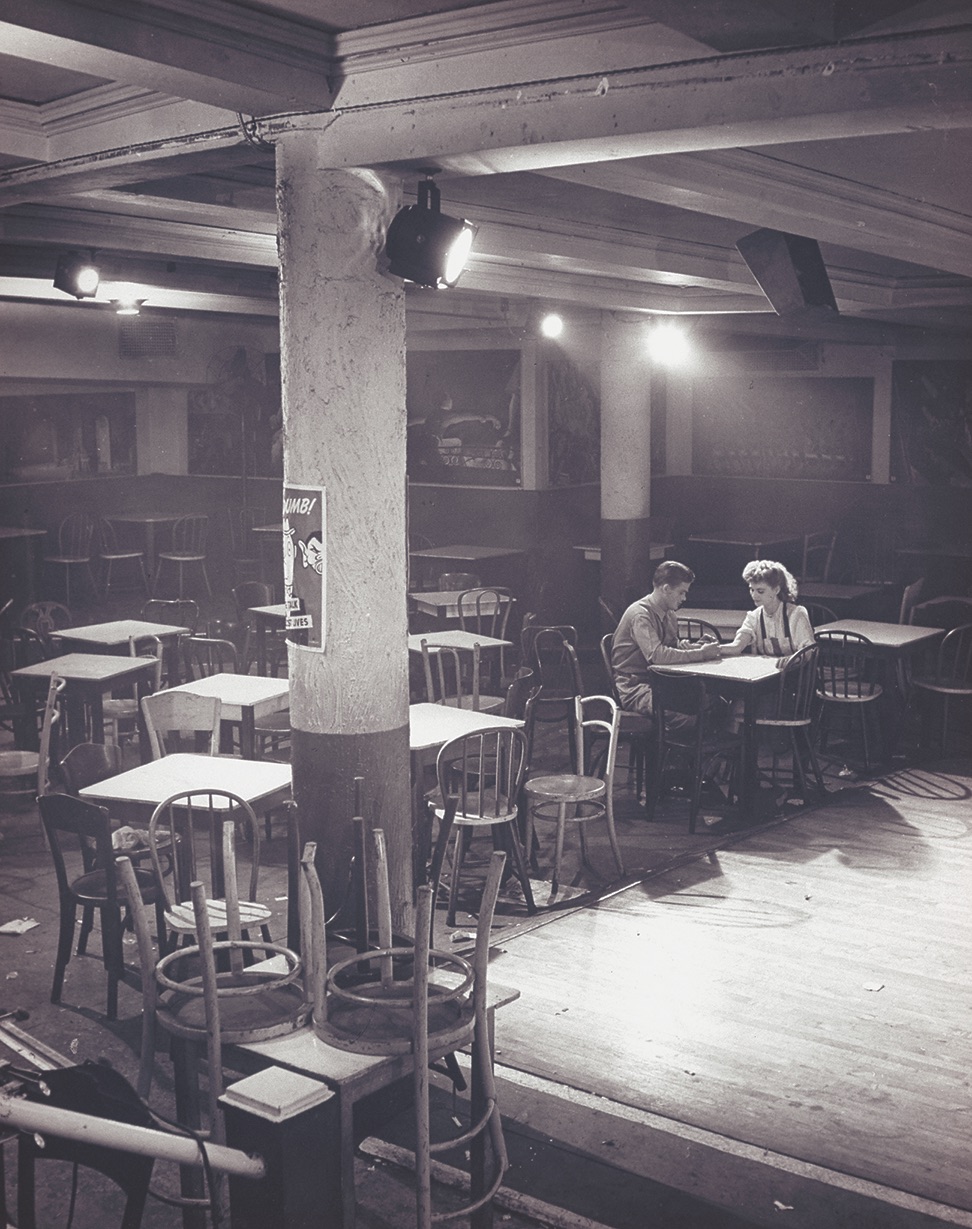
Some hostesses enrolled in nursing classes to learn how to detect and deal with guests showing signs of what was then generally called “shellshock”—now known as posttraumatic stress disorder. “Suddenly the canteen has found that it plays host to more and more boys with somber steps and faces painted with memories,” wrote the same hostess—“boys with Guadalcanal in their eyes and the south Pacific in their hearts, the guns in the Solomons pounding in their ears and horrible sounds unlike those any civilian ever heard still chanting on their nerves.”
A simpler, perhaps inevitable problem was the gradual erosion of the dating rule, which was outflanked in a joint operation by both servicemen and junior hostesses. (One of the couples portrayed in the movie Hollywood Canteen was shown violating the dating strictures.)
After Allied forces advanced into Europe, a Stage Door Canteen was even opened in liberated Paris. Located on the Champs-Élysées, it was open to troops of all Allied nations, but GIs dominated the clientele. American WACs came in to help French hostesses handle the overflow crowd and coach them in American idioms. Noël Coward was there, as was Maurice Chevalier, who of course sang “Mimi.” Marlene Dietrich was mobbed by soldiers after her act. “But what do you want with me?” she cried, with feigned naiveté.
But the fact that a Stage Door Canteen could be opened in the former Occupied France was evidence that the canteens back in the States had done their job, and they began to close after V-J Day. The original New York canteen actually closed twice, first when its lease beneath the 44th Street Theater expired on June 30, 1945. From there it moved to the Crystal Room in the Hotel Diplomat, where it closed for good the following October.
Canteens across the country also began shutting down that fall. If an epilogue were wanted, it might consist of those servicemen who returned to claim the hearts they had left at the Stage Door Canteen. MHQ
John Vacha, a retired teacher of history and journalism, is the author of four books on the history of regional theater. He is completing a book on Cleveland’s Playhouse Square theater district.
[hr]
This article appears in the Summer 2020 issue (Vol. 32, No. 4) of MHQ—The Quarterly Journal of Military History with the headline: ‘Meet me at the Canteen’

Want to have the lavishly illustrated, premium-quality print edition of MHQ delivered directly to you four times a year? Subscribe now at special savings!

